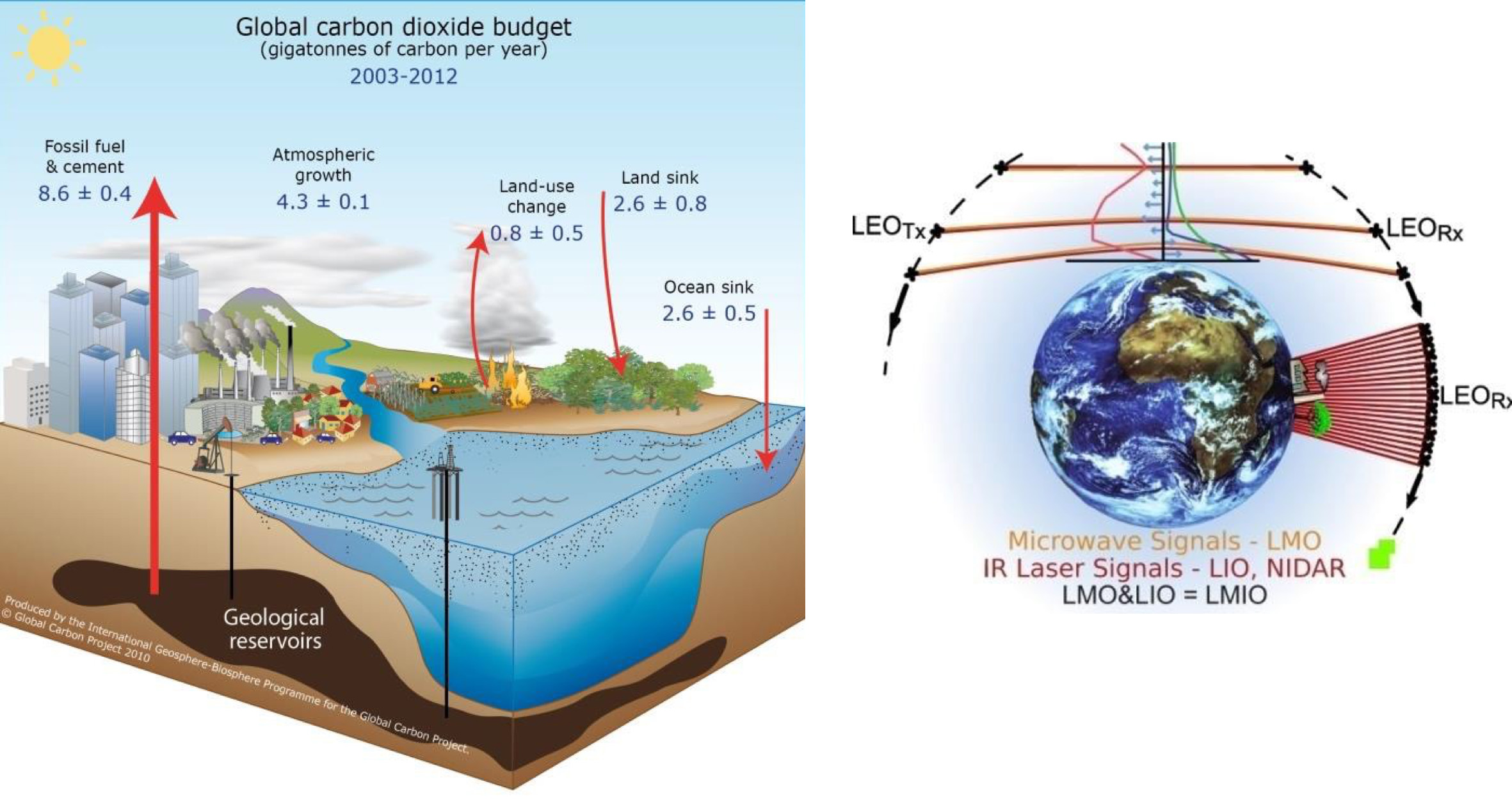Exploring Greenhouse Gases, Water and Climate Changes by LEO-LEO Occultation

Image Credit: Global Carbon Project 2010 & WEGC
OVERVIEW
Context
The atmospheric thermodynamic state variables (i.e., temperature, pressure, humidity, etc.) and greenhouse gases are essential climate variables (ECVs) and significant in physical/chemical processes of the atmosphere, which play very important roles in the earth system, ecosystem and human society. The responses and feedback of these ECVs to global change are one of the key questions in the earth science. However, the existing ground-based and satellite observations are still far from enough to function properly in atmospheric physics and global climate change research that requires long-term stable, global coverage, high spatial resolution and simultaneous measurement of these ECVs, to deliver atmosphere and climate benchmark data. The benchmark observations also helpful to understand the exchanges among the atmospheric water vapor, ice liquid water and ice crystals, under strong convection conditions.
The GNSS radio occultation (RO) has become a major method to observe the atmospheric thermodynamic state variables, which demonstrated the occultation observations have the atmosphere and climate benchmark data features. However, the GNSS RO has temperature and humidity temperature-humidity ambiguity problem. Fortunately, as an advanced technique microwave occultation-using centimeter and millimeter wave signals between low Earth orbit satellites (LEO-LEO microwave occultation, LMO) can exploit both the refraction and absorption of the signals to solve the temperature-humidity ambiguity in the troposphere. Thus LMO enables to retrieve pressure, temperature, and humidity profiles without background information. Liquid water and rain rate profiles as well as turbulence and complementary 3D cloud information can be co-observed.
Additionally, the LEO-LEO infrared-laser occultation (LIO), using laser signals in the short-wave infrared band 2–2.5 m between LEO satellites, has been designed to accurately observe key trace gas species for chemistry and climate (i.e., greenhouse gases H2O, CO2, CH4, N2O, O3, CO, etc.), line-of-sight wind speed, and also profiles of cloud layers and aerosols as by-products. LIO observes the absorption of the signals to retrieve volume mixing ratio (VMR) profiles of the greenhouse gases. In order to mitigate the effects of foreign species absorption, aerosol extinction, scintillation, and scattering on the retrieved trace species profiles, LIO uses the differential transmission principle between carefully selected pairs of absorption signals and reference signals. This enables accurate retrieval of the pure absorption profile due to the target species and hence accurate greenhouse gas profiles.
In the last decade, ESA and NASA have proposed several LMO and LIO missions for atmosphere and climate change, and done many pre-studies. In China, an Climate and Atmospheric Components Exploring Satellites (CACES) mission concept has been proposed to the Strategic Priority Research Program of Chinese Academy Science (SPRPCAS). A mission for benchmark monitoring of the Earth's atmospheric thermodynamic state variables, greenhouse gases and climate change by microwave and infrared-laser crosslink occultation and 3D clouds imaging from low Earth orbits.
The aims of this ISSI-BJ FORUM are to discuss: 1) the key scientific questions of responses and feedbacks of ECVs physical/chemical processes to global change; 2) the scientific objectives and observation requirements of CACES mission; 3) the LMO/LIO techniques in terms of principles, algorithms and payloads.
Objectives
Date: 24-26 July 2019
CONVENERS
| Maurizio Falanga | ISSI-BJ, China |
| Fan Quanlin | NSSC, CAS, China |
| Gottfried Kirchengast | WEGC, University of Graz, Austria |
| Liu Congliang | NSSC, CAS, China |
| Armin Loescher | ESA Future Missions & Instruments Division, Netherlands |
| Lv Daren | IAP, CAS, China |
| Sun Yueqiang | NSSC, CAS, China |
| Stig Syndergaard | DMI Copenhagen, Denmark |
| Wang Xin | IAP, CAS, China |